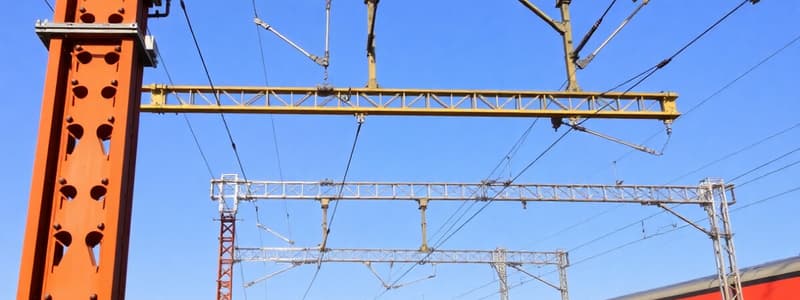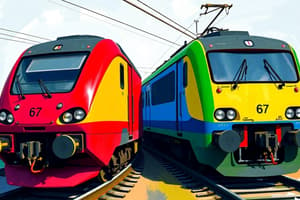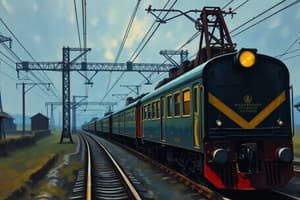Podcast
Questions and Answers
What is the main purpose of a neutral section in overhead equipment?
What is the main purpose of a neutral section in overhead equipment?
- To provide a resting area for electric trains
- To separate the areas fed by adjacent substations (correct)
- To allow locomotives to pause and recharge
- To increase voltage supply to the overhead equipment
Why are warning boards provided in advance of a neutral section?
Why are warning boards provided in advance of a neutral section?
- To alert passengers about upcoming stops
- To indicate a change in train speed limits
- To signal the end of a feeding post
- To remind the loco pilot to open the circuit breaker (correct)
How many interrupters are typically provided at each Sub-Sectioning Post (SSP) in a double track section?
How many interrupters are typically provided at each Sub-Sectioning Post (SSP) in a double track section?
- Three (correct)
- Two
- Four
- One
What equipment is installed at switching stations to protect against voltage surges?
What equipment is installed at switching stations to protect against voltage surges?
What should a train do when approaching a neutral section?
What should a train do when approaching a neutral section?
What is the function of Auxiliary transformers at switching stations?
What is the function of Auxiliary transformers at switching stations?
Where should neutral sections be located for optimal operation?
Where should neutral sections be located for optimal operation?
Which of the following provides monitoring for power supply to sub-sectors?
Which of the following provides monitoring for power supply to sub-sectors?
What does the first letter in the code for electric locomotives denote?
What does the first letter in the code for electric locomotives denote?
Which letter is used to denote locomotives suitable for mixed traffic services?
Which letter is used to denote locomotives suitable for mixed traffic services?
What type of pantograph is commonly used by Indian Railways for electric locomotives?
What type of pantograph is commonly used by Indian Railways for electric locomotives?
What is the maximum operational speed suitable for the pantograph described in the content?
What is the maximum operational speed suitable for the pantograph described in the content?
What is the typical equivalent copper section for catenary and contact wires together?
What is the typical equivalent copper section for catenary and contact wires together?
Which code letter represents locomotives meant exclusively for freight services?
Which code letter represents locomotives meant exclusively for freight services?
Which equipment is used for collecting power from overhead contact wires in electric locomotives?
Which equipment is used for collecting power from overhead contact wires in electric locomotives?
What is the maximum permissible current on a single track due to the size of the overhead equipment?
What is the maximum permissible current on a single track due to the size of the overhead equipment?
What is the normal height of the contact wire for regulated overhead equipment above rail level?
What is the normal height of the contact wire for regulated overhead equipment above rail level?
What technology is used to raise and lower the pantograph?
What technology is used to raise and lower the pantograph?
For unregulated overhead equipment in areas with a temperature range of 4°C to 65°C, what is the height of the contact wire?
For unregulated overhead equipment in areas with a temperature range of 4°C to 65°C, what is the height of the contact wire?
What classification is given to electric multiple units (EMUs)?
What classification is given to electric multiple units (EMUs)?
Which of the following pantograph features improves operational speed potential?
Which of the following pantograph features improves operational speed potential?
In the context of overhead equipment, what material is used for the contact wire?
In the context of overhead equipment, what material is used for the contact wire?
What is the purpose of using carbon strips in pantographs?
What is the purpose of using carbon strips in pantographs?
What is the maximum span used for supporting overhead equipment on straight tracks?
What is the maximum span used for supporting overhead equipment on straight tracks?
At what maximum interval are catenary systems normally supported on straight tracks?
At what maximum interval are catenary systems normally supported on straight tracks?
What is the diameter of the droppers supporting the contact wire?
What is the diameter of the droppers supporting the contact wire?
How far apart are droppers spaced for the contact wire?
How far apart are droppers spaced for the contact wire?
What is the minimum height of contact wire under over-line structures for broad gauge (BG)?
What is the minimum height of contact wire under over-line structures for broad gauge (BG)?
What design change is necessary for pantographs using carbon strips compared to those using steel strips?
What design change is necessary for pantographs using carbon strips compared to those using steel strips?
What is the approximate speed potential of pantographs designed for carbon strips?
What is the approximate speed potential of pantographs designed for carbon strips?
What is the life expectancy of main contacts in Vacuum Circuit Breakers (VCB) as compared to Air Blast Circuit Breakers?
What is the life expectancy of main contacts in Vacuum Circuit Breakers (VCB) as compared to Air Blast Circuit Breakers?
Which of the following is an advantage of Vacuum Circuit Breakers over Air Blast Circuit Breakers?
Which of the following is an advantage of Vacuum Circuit Breakers over Air Blast Circuit Breakers?
What role does the regulating winding in a traction power transformer serve?
What role does the regulating winding in a traction power transformer serve?
What is the primary purpose of staggering the contact wire in the pantograph system?
What is the primary purpose of staggering the contact wire in the pantograph system?
How far does the pantograph sweep across the contact wire on straight runs?
How far does the pantograph sweep across the contact wire on straight runs?
What is a key difference between uninsulated and insulated overlap spans?
What is a key difference between uninsulated and insulated overlap spans?
What type of OHE system is typically used for main lines?
What type of OHE system is typically used for main lines?
At what maximum speed should section insulators be installed if their runners are facing the direction of travel?
At what maximum speed should section insulators be installed if their runners are facing the direction of travel?
What typically bridges the electrical discontinuity at insulated overlaps?
What typically bridges the electrical discontinuity at insulated overlaps?
What is the distance between two contact wires in uninsulated overlap spans?
What is the distance between two contact wires in uninsulated overlap spans?
Why is automatic tensioning not used for certain lines?
Why is automatic tensioning not used for certain lines?
What is the function of section insulators in the OHE system?
What is the function of section insulators in the OHE system?
What is a consequence if the section insulator assembly is not installed properly?
What is a consequence if the section insulator assembly is not installed properly?
What character in the classification code for electric rolling stock indicates the system of power supply?
What character in the classification code for electric rolling stock indicates the system of power supply?
Which pantograph design is specifically mentioned as being suitable for operation up to 140 km/h?
Which pantograph design is specifically mentioned as being suitable for operation up to 140 km/h?
What does the letter 'U' represent in the classification of Multiple Unit Stock?
What does the letter 'U' represent in the classification of Multiple Unit Stock?
Which pantograph improvement is mentioned as a way to enhance the life of the contact wire?
Which pantograph improvement is mentioned as a way to enhance the life of the contact wire?
What is the significance of the letter 'G' in the classification of electric locomotives?
What is the significance of the letter 'G' in the classification of electric locomotives?
What is the primary function of a feeding post in the electric traction system?
What is the primary function of a feeding post in the electric traction system?
How are sectioning and paralleling posts utilized in the overhead equipment system?
How are sectioning and paralleling posts utilized in the overhead equipment system?
What feature allows for the isolation of the overhead equipment at closer intervals?
What feature allows for the isolation of the overhead equipment at closer intervals?
What essential component is provided at sections of the overhead equipment for maintenance purposes?
What essential component is provided at sections of the overhead equipment for maintenance purposes?
What is the role of bridging interrupters located at sectioning and paralleling posts?
What is the role of bridging interrupters located at sectioning and paralleling posts?
What typically determines the spacing of traction sub-stations along electrified routes?
What typically determines the spacing of traction sub-stations along electrified routes?
For localized shutdown of power supply during maintenance at watering stations, which equipment is used?
For localized shutdown of power supply during maintenance at watering stations, which equipment is used?
What mechanism is used for ensuring rapid isolation of faults on the overhead equipment?
What mechanism is used for ensuring rapid isolation of faults on the overhead equipment?
What is the equivalent copper section for the catenary and contact wires together in certain sections of Waltair-Kirandul?
What is the equivalent copper section for the catenary and contact wires together in certain sections of Waltair-Kirandul?
What is the permissible current on a single track due to the equivalent cross-sectional area of overhead equipment?
What is the permissible current on a single track due to the equivalent cross-sectional area of overhead equipment?
What is the maximum height for regulated overhead equipment above rail level for normal conditions?
What is the maximum height for regulated overhead equipment above rail level for normal conditions?
How far apart should the droppers supporting the contact wire be spaced?
How far apart should the droppers supporting the contact wire be spaced?
What type of wire is used for the contact wire in tramway type overhead equipment?
What type of wire is used for the contact wire in tramway type overhead equipment?
What is the maximum span for supporting the catenary system on straight tracks?
What is the maximum span for supporting the catenary system on straight tracks?
At what height can the contact wire be set in areas with a temperature range of 15°C to 65°C?
At what height can the contact wire be set in areas with a temperature range of 15°C to 65°C?
What diameter is specified for the droppers supporting the contact wire?
What diameter is specified for the droppers supporting the contact wire?
What design does the cantilever type bracket assembly support the OHE from?
What design does the cantilever type bracket assembly support the OHE from?
Which temperature limit is used for determining the permissible current on a single track?
Which temperature limit is used for determining the permissible current on a single track?
What is the distance the pantograph sweeps across the contact wire on curved runs?
What is the distance the pantograph sweeps across the contact wire on curved runs?
What is the primary function of the section insulator assembly in the OHE system?
What is the primary function of the section insulator assembly in the OHE system?
What is a characteristic feature of uninsulated overlap spans?
What is a characteristic feature of uninsulated overlap spans?
What is the typical separation distance between two contact wires in uninsulated overlap spans?
What is the typical separation distance between two contact wires in uninsulated overlap spans?
What is the maximum speed at which section insulators should be installed if their runners overlap and are facing the direction of travel?
What is the maximum speed at which section insulators should be installed if their runners overlap and are facing the direction of travel?
For what type of lines is unregulated OHE typically used?
For what type of lines is unregulated OHE typically used?
What is the distance at which the overlap of OHE conductors is generally terminated?
What is the distance at which the overlap of OHE conductors is generally terminated?
What device is typically used to bridge electrical discontinuity at insulated overlaps?
What device is typically used to bridge electrical discontinuity at insulated overlaps?
What ensures uniform wear of the current collecting strips of the pantograph?
What ensures uniform wear of the current collecting strips of the pantograph?
What adjustment is made to the height of the conductor at overlaps?
What adjustment is made to the height of the conductor at overlaps?
What precaution should be taken when closing bridging interrupters?
What precaution should be taken when closing bridging interrupters?
Which statement accurately describes a Neutral Section?
Which statement accurately describes a Neutral Section?
What is the function of an Auxiliary transformer at switching stations?
What is the function of an Auxiliary transformer at switching stations?
What type of equipment is provided to protect against voltage surges in a sub-sector?
What type of equipment is provided to protect against voltage surges in a sub-sector?
Why are remote control equipment and batteries housed in a masonry cubicle?
Why are remote control equipment and batteries housed in a masonry cubicle?
What is a requirement for the location of neutral sections?
What is a requirement for the location of neutral sections?
What is the purpose of warning boards before a neutral section?
What is the purpose of warning boards before a neutral section?
How many interrupters are typically provided at a Sub-Sectioning Post (SSP) for double track sections?
How many interrupters are typically provided at a Sub-Sectioning Post (SSP) for double track sections?
What feature distinguishes Sub-Sectioning Posts (SS) from Sub-Sectioning Posts (SSP)?
What feature distinguishes Sub-Sectioning Posts (SS) from Sub-Sectioning Posts (SSP)?
What is the role of potential transformers at switching stations?
What is the role of potential transformers at switching stations?
Flashcards are hidden until you start studying
Study Notes
Bridging Interrupters
- Bridging interrupters are normally open and should only be closed with special precautions.
- Interrupters are designed to prevent the pantograph of an electric locomotive from bridging different phases of the 25kV supply.
Sub-Sectioning and Paralleling Posts (SSP)
- SSPs are located between each feeding post and adjacent sub-sectioning post.
- SSPs connect adjacent sub-sectors of up and down tracks in a double track section.
Sub-Sectioning Post (SS)
- SSs are located only occasionally.
- SSs are similar to SSPs but do not have paralleling capabilities.
Neutral Section
- A neutral section is a short, insulated and dead section of overhead equipment.
- Neutral sections separate areas fed by different substations or feeding posts.
- Neutral sections are located on level tangent tracks.
- Loco pilots must open the locomotive circuit breaker and coast through the neutral section.
Important Equipment at Switching Stations:
- Lightning Arresters: protect each sub-sector against voltage surges.
- Auxiliary Transformers: provide a 240V, 50Hz AC supply for signaling and operational lighting.
- Potential Transformers: monitor the supply to each sub-sector.
- Remote Control Equipment: accommodate control panel, telephone, batteries, and battery chargers.
Overhead Equipment
Catenary and Contact Wires:
- Catenary wire is made of stranded cadmium copper (65mm2) or stranded aluminium alloy (116mm2).
- Contact wire is made of grooved hard drawn copper (107mm2) and is suspended from the catenary by droppers.
- The combined cross-sectional area of catenary and contact wire is 157mm2.
- The current permissible on a single track is approximately 600A.
- Some sections have an equivalent copper cross-section of 200mm2.
Height of Contact Wire:
- Regulated OHE contact wire height is 5.60m above rail level.
- Unregulated OHE contact wire height is 5.75m or 5.65m based on temperature ranges.
- Height can be reduced (4.65m BG, 4.02m MG) under over-line structures.
Span of Supporting Mast/Structures:
- Spans vary from 72m on straight tracks to 27m on curved tracks.
- Catenary is supported at a maximum interval of 72m (63m on MG) on straight tracks.
Stagger:
- The contact wire is staggered to ensure uniform wear of the pantograph's current collecting strips.
- Stagger is 200mm on straight tracks and 300mm on curves.
Overlaps:
- Overlaps occur at intervals of 1.5km and facilitate smooth pantograph transition.
- Uninsulated Overlaps: Two contact wires are connected by jumpers with 200mm separation.
- Insulated Overlaps: Two OHE systems are 500mm apart and are connected by interrupters.
Regulated and Unregulated OHE
- Regulated OHE uses automatic tensioning and is used for main lines.
- Unregulated OHE is used for yards and unimportant lines for economic reasons.
Section Insulator Assembly:
- Section insulators isolate the OHE of one elementary section from the next.
- Section insulators are positioned at cross-overs, allowing current collection to shift between tracks smoothly.
- Maximum speed for section insulator assemblies with trailing runners is 120km/h.
- Maximum speed for section insulator assemblies with facing runners or not installed within the first third of the span is 80kmh.
Electric Rolling Stock
Classification of Electric Rolling Stock:
- Locos and EMUs are classified with a three/four letter code followed by a class number.
- Gauge: W (BG) or Y (MG).
- Power Supply: A (AC), C (DC), CA (DC & AC).
- Locos: M (Mixed Traffic), G (Freight), P (Passenger), S (Shunting).
- EMUs: U.
Important Equipment of Electric Loco/EMU:
-
Pantograph:
- AM12 pantograph is used for 25kV AC electric locomotives and EMUs.
- It uses steel strips for current collection and is operated by a pneumatic servo motor.
- The suspension is on plungers and is suitable for operation up to 140kmh.
- Improved pantographs with lower dynamic mass and independent pan heads are used for higher speeds (250kmh).
- Carbon strips can be used for better lifespan of the contact wire, demanding more flexible pan head design.
-
Circuit Breaker:
- Air Blast Circuit Breaker: Breaks fault current with a breaking capacity of 250MVA.
- Vacuum Circuit Breaker (VCB): Introduced in 1985.
- Simplified design with fewer parts.
- Self-contained interrupting medium (vacuum).
- Higher life expectancy (1 lakh operations).
- Reduced size, weight, and maintenance cost.
- Faster trip-time (less than 60 milliseconds).
- Handles fault currents during closing (making capacity of 250MVA).
-
Transformer:
- Steps down 25kV AC single-phase power from the contact wire.
- Contains primary, regulating, traction secondary, and auxiliary windings.
- Regulating winding adjusts voltage for traction motors.
- Auxiliary winding powers auxiliary motors.
- Increases the horsepower of the locomotive.
-
Traction Motors:
- Convert electrical energy to mechanical energy.
- Usually DC motors used for locomotive propulsion.
- Connected to the transformer's secondary winding.
- Control the speed and torque of the locomotive.
- Can be series-wound or separately-excited.
-
Braking System:
- Used to stop or slow down the locomotive.
- Can be electric, pneumatic, or a combination.
- Electric braking uses traction motors as generators to create resistance.
- Pneumatic braking uses air pressure to apply brakes to the wheels.
-
Control System:
- Controls the operation of the locomotive.
- Includes throttle, brakes, and various electrical switches.
- Can be manual or automatic.
Power Supply
- Electric traction uses a 25kV, AC, 50Hz single-phase power supply.
- Power is supplied from the State Electricity Boards through traction sub-stations.
- Sub-stations are located 35-50km apart, with distances varying based on traffic volume and train load.
Overhead Equipment Sectioning
- Overhead equipment (OHE) is sectioned to isolate faults and facilitate maintenance.
- Sections are typically 10-15km long.
- Each section contains:
- Switching Stations: Include interrupters rated at 600A to isolate the section.
- Sub-Sectors: The shortest section that can be isolated by interrupters alone.
- Elementary Sections: Smaller sections within the sub-sector, isolated by manual isolator switches.
Types of Switching Stations
- Feeding Post (FP): Incoming power is fed from the grid substation. Each feeder supplies OHE on one side of the FP through interrupters.
- Sectioning and Paralleling Post (SP): Located midway between FP's, marking the boundary between zones.
- Paralleling interrupter: Parallels OHE for up and down tracks on double-track sections.
- Bridging interrupter: Allows one FP to feed beyond the SP if its supply is interrupted (remains open unless necessary).
- Sub-Sectioning and Paralleling Post (SSP): One or more per FP/SP pair.
- Three interrupters connect adjacent sub-sectors of up and down tracks on double-track sections.
- Sub-Sectioning Post (SS): Similar to SSP but without paralleling.
Neutral Section
- An insulated "dead zone" separating areas fed by different sub-stations.
- Prevents pantographs from bridging phases while transitioning between sub-stations.
- Loco pilots must open circuit breakers before entering and after exiting neutral sections.
- Located on level tangent tracks to avoid stalling during coasting through the section.
Equipment at Switching Stations
- Lightning Arresters: Protect sub-sectors from voltage surges.
- Auxiliary Transformers: Provide 240V, 50Hz AC for signaling and lighting.
- Potential Transformers: Monitor power supply to individual sub-sectors.
- Remote Control Equipment: Control panels, telephones, batteries and chargers for interrupters and other equipment.
Overhead Equipment (OHE)
- Catenary Wire: Stranded cadmium copper (65mm2) or aluminium alloy (116mm2).
- Contact Wire: Grooved, hard-drawn copper (107mm2) supported by catenary via droppers.
- Combined Equivalent Copper Section: 157mm2 for main lines, permitting 600A current.
- Loop Lines, Sidings, Yards: Only contact wire (107mm2).
Height of Contact Wire
- Regulated OHE: 5.60m above rail level (with pre-sag).
- Unregulated OHE: 5.75m (4°C to 65°C) or 5.65m (15°C to 65°C).
- Lower heights possible under bridges, requiring special precautions for oversize loads.
Span of Supporting Structures
- Straight Track: Maximum 72m (63m for MG).
- Curved Tracks: Decrees with curvature.
- Supported by cantilever arms fixed to steel masts or structures.
Stagger
- Enables uniform wear of pantograph contact strips.
- Straight Track: 200mm offset on either side of centerline.
- Curves: 300mm offset on one side.
Overlaps
- OHE conductors terminated with overlaps every 1.5km to ensure smooth pantograph transition.
- Uninsulated: 200mm separation, conductors permanently connected by jumpers.
- Insulated: 500mm separation, bridged by interrupters/isolators except at neutral sections.
Regulated and Unregulated OHE
- Regulated OHE: Uses automatic tensioning, standard for main lines.
- Unregulated OHE: Used in isolated yards and unimportant lines, for cost savings.
Section Insulator Assembly
- Insulates OHE of adjacent elementary sections, like at cross-overs.
- Enables smooth current collection during transitions between tracks.
- Assemblies with porcelain insulators are suitable for speeds up to 120km/hr when placed within the first one-third of the span.
- Speed limit of 80km/h is required when runners are in the facing direction or section insulator assembly is placed outside the first one-third span.
Electric Rolling Stock Classification
- Three-letter code:
- First letter: Gauge (W for BG, Y for MG).
- Second letter: Power supply (A for AC, C for DC, CA for AC/DC).
- Third letter: Service (M for mixed traffic, G for freight, P for passenger, S for shunting).
- Four-letter code: Add "U" for Multiple Unit Stock (EMUs).
Examples
- AC Locomotives: WAG1, WAG2, WAG3, WAG4, WAG5, WAG6, WAG7, WAG9, WAG9M
- AC/DC Locomotives: WCAM1
- AC EMUs: WAU1, WAU2, WAU3, WAU4, YAU
Important Equipment of Electric Loco/EMU
- Pantograph: Collects power from the contact wire, mounted on the roof of vehicles.
- AM 12 Pantograph: Widely adopted in India, uses steel strips for current collection and is pneumatically operated.
- Pantographs for Higher Speeds: Improved design with lower dynamic mass and independent pan heads.
- Carbon Strips: Increasingly used to enhance contact wire lifespan.
Studying That Suits You
Use AI to generate personalized quizzes and flashcards to suit your learning preferences.




